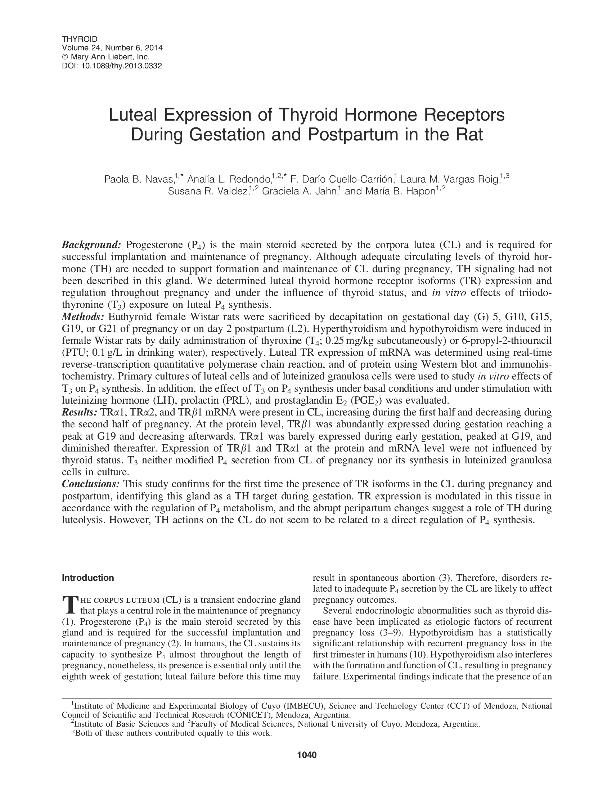Artículo
Luteal expression of thyroid hormone receptors during gestation and postpartum in the rat.
Navas López, Paola Beatriz ; Redondo, Analia Lourdes
; Redondo, Analia Lourdes ; Cuello Carrión, Fernando Darío
; Cuello Carrión, Fernando Darío ; Vargas Roig, Laura Maria
; Vargas Roig, Laura Maria ; Valdez, Susana Ruth
; Valdez, Susana Ruth ; Jahn, Graciela Alma
; Jahn, Graciela Alma ; Hapon, María Belén
; Hapon, María Belén
 ; Redondo, Analia Lourdes
; Redondo, Analia Lourdes ; Cuello Carrión, Fernando Darío
; Cuello Carrión, Fernando Darío ; Vargas Roig, Laura Maria
; Vargas Roig, Laura Maria ; Valdez, Susana Ruth
; Valdez, Susana Ruth ; Jahn, Graciela Alma
; Jahn, Graciela Alma ; Hapon, María Belén
; Hapon, María Belén
Fecha de publicación:
03/2014
Editorial:
Mary Ann Liebert
Revista:
Thyroid
ISSN:
1050-7256
Idioma:
Inglés
Tipo de recurso:
Artículo publicado
Clasificación temática:
Resumen
BACKGROUND: Progesterone (P4) is the main steroid secreted by the corpora lutea (CL) and is required for successful implantation and maintenance of pregnancy. Although adequate circulating levels of thyroid hormone (TH) are needed to support formation and maintenance of CL during pregnancy, TH signaling had not been described in this gland. We determined luteal thyroid hormone receptor isoforms (TR) expression and regulation throughout pregnancy and under the influence of thyroid status, and in vitro effects of triiodothyronine (T3) exposure on luteal P4 synthesis.
METHODS: Euthyroid female Wistar rats were sacrificed by decapitation on gestational day (G) 5, G10, G15, G19, or G21 of pregnancy or on day 2 postpartum (L2). Hyperthyroidism and hypothyroidism were induced in female Wistar rats by daily administration of thyroxine (T4; 0.25 mg/kg subcutaneously) or 6-propyl-2-thiouracil (PTU; 0.1 g/L in drinking water), respectively. Luteal TR expression of mRNA was determined using real-time reverse-transcription quantitative polymerase chain reaction, and of protein using Western blot and immunohistochemistry. Primary cultures of luteal cells and of luteinized granulosa cells were used to study in vitro effects of T3 on P4 synthesis. In addition, the effect of T3 on P4 synthesis under basal conditions and under stimulation with luteinizing hormone (LH), prolactin (PRL), and prostaglandin E2 (PGE2) was evaluated.
RESULTS: TRα1, TRα2, and TRβ1 mRNA were present in CL, increasing during the first half and decreasing during the second half of pregnancy. At the protein level, TRβ1 was abundantly expressed during gestation reaching a peak at G19 and decreasing afterwards. TRα1 was barely expressed during early gestation, peaked at G19, and diminished thereafter. Expression of TRβ1 and TRα1 at the protein and mRNA level were not influenced by thyroid status. T3 neither modified P4 secretion from CL of pregnancy nor its synthesis in luteinized granulosa cells in culture.
CONCLUSIONS: This study confirms for the first time the presence of TR isoforms in the CL during pregnancy and postpartum, identifying this gland as a TH target during gestation. TR expression is modulated in this tissue in accordance with the regulation of P4 metabolism, and the abrupt peripartum changes suggest a role of TH during luteolysis. However, TH actions on the CL do not seem to be related to a direct regulation of P4 synthesis.
Palabras clave:
Corporea-Lutea
,
Thyroid-Hormone
,
Receptors
,
Gestation
,
Postpartum
,
Rat
Archivos asociados
Licencia
Identificadores
Colecciones
Articulos(IMBECU)
Articulos de INST. DE MEDICINA Y BIO. EXP. DE CUYO
Articulos de INST. DE MEDICINA Y BIO. EXP. DE CUYO
Citación
Valdez, Susana Ruth; Vargas Roig, Laura Maria; Jahn, Graciela Alma; Redondo, Analia Lourdes; Cuello Carrión, Fernando Darío; Navas López, Paola Beatriz; et al.; Luteal expression of thyroid hormone receptors during gestation and postpartum in the rat.; Mary Ann Liebert; Thyroid; 48; 2; 3-2014; 1040-1050
Compartir
Altmétricas



